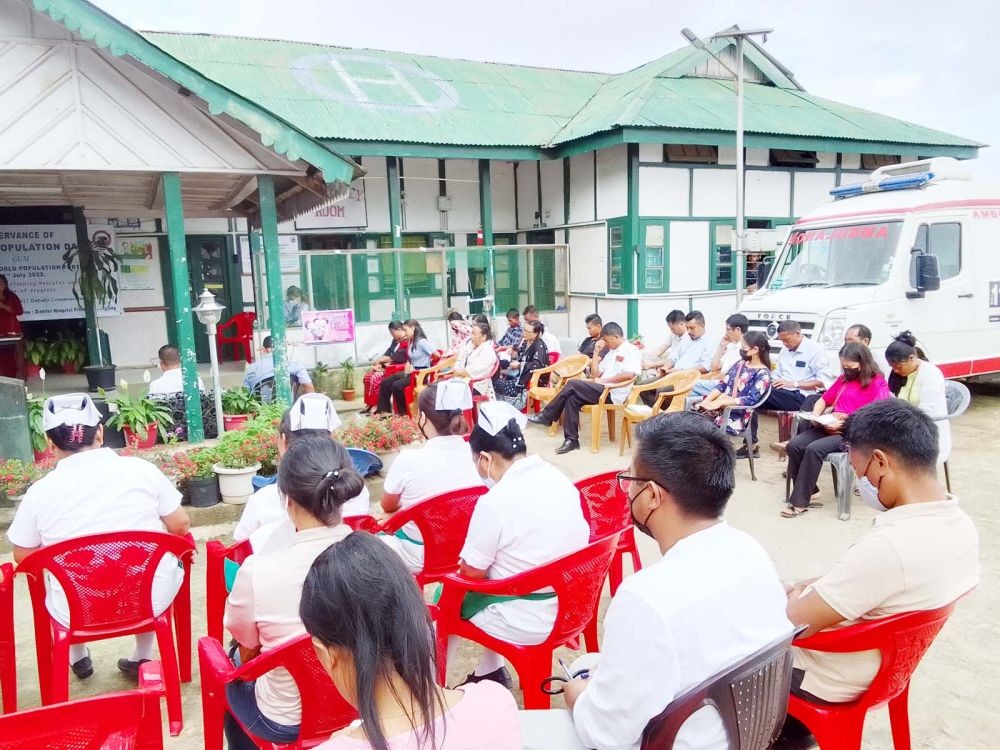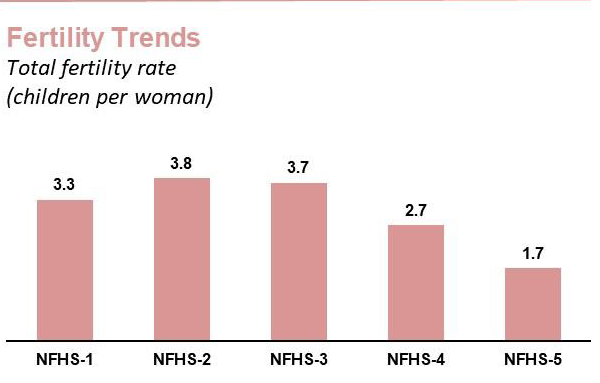Participants of the World Population Day 2022 at District Hospital Longleng on July 11.

Moa Jamir
Dimapur | July 11
“Marry at the right age. Plan before having children. Keep adequate spacing between two-child,” the National Health Mission (NHM) Nagaland advised on World Population Day on July 11, while further urging men to take equal responsibility in planning a family.
As if to heed the call, Nagaland Minister of Higher Education & Tribal Affairs Temjen Inna Along invited netizens to “join single movement today” and “contribute towards a sustainable future.”
Elsewhere, the United Nations forecasted that India will overtake China as the most populous country in the world by 2023. Both now have over 1.4 billion people each; studies have predicted more decline of China's population. The world’s population is expected to reach 8 billion on November 15, 2022.
As per the 2011 Census, Nagaland has a population of 19.79 lakh, a decrease from figure of 19.90 lakh in 2001 census, indicating a -0.58 percent decadal growth. However, it is expected to increased marginally in ongoing 2021 Census, as the 2011 data was considered more a data stabilisation, after a contentious 2001 data.
The report of the Technical Group on Population Projections by the National Commission on Population, Ministry of Health & Family Welfare in July 2020 has projected Nagaland’s population for 2021 at 21.92 lakh and 22.94 lakh in 2026.
Accordingly, as advisories are issued and debate over demographic dividend or disaster continues, The Morung Express delved further into understanding family planning and populations in Nagaland by analysing the latest National Family Health Survey-5.

Decreasing fertility rates
As per the UN, an even bigger headline than 8 billion population is fertility rates, which are at a historic low. It is verifiable for India and Nagaland.
As per the NFHS-5, the total fertility rate (TFR) or children per woman was 1.7 in Nagaland, well below replacement level of 2.1. The replacement level is understood as the level of fertility at which a population replaces itself exactly from one generation to the next, without migration.
In urban areas, the TFR was at 1.2 children per woman while in rural areas, it was 2. In fact, TFR has been consistently declining in Nagaland and was down by 1 children between NFHS 4 (2.7) conducted in 2015-16 and NFHS-5 (2019-21). It was 3.7 during the NFHS-3. During the same period, the TFR in India was 2.0 children per woman, which declined from 2.2 in 2015-16.
Increasing median age of marriage
One possible contributor to the declining TFR could be the increase in median age of first marriage in Nagaland.
As per the NFHS-5, the median age at first marriage was 23.9 years among women aged 25-49, while 30% women aged 20-49 years were never married, compared with 43% of men aged 20-49.
It was 22.3 years for women in NFHS-4, while it was 27 among men aged 30-49 years.
Further, women aged 20-24 years getting married before attaining the legal minimum fell to just 6% in NHFS-5 from 13% in NFHS-4. It was 18% in NFHS-3.
In Nagaland, among younger women aged 15-19, 4% have already begun childbearing during NFHS-5 while it was 7% across India.
Nationally, the median age of first marriage was 19.2 years among women aged 20-49 and 24.9 years among men aged 25-49, while 13% of women aged 20-24 years got married before the legal minimum age of 18.
Family planning
Meanwhile, the NFHS-5 also informed that knowledge of contraception is almost universal in Nagaland, while it was 56% in India.
However, only 38% of all women and 55% of currently married women in Nagaland know about the Lactational Amenorrhoea Method (LAM), and 14% of currently married had knowledge about female condoms. Among all women, only 39% know about emergency contraception.
The Contraceptive Prevalence Rate (CPR) among currently married women aged 15-49 was 57%, a two-fold increase from NFHS-4 (27%).
The use of modern family planning methods (45%) has also substantially increased from its level in NFHS-4 (21%).
Female sterilisation is still the most popular contraceptive method, used by 38% of currently married women while overall it increased from 9% to 14%, in Nagaland between NFHS-4 and NFHS-5. It was 33% across India. Interestingly, the NFHS-5 noted that women in Nagaland are more likely to use contraception if they already have a son.
The most common modern spacing methods used by currently married women in Nagaland are IUD or PPIUD (20%), followed by the pill (6%) and condoms (3%).
However, at 29.6 months, the median interval between births in the five years before the survey was in Nagaland was lower than 33 months nationally.
Meanwhile, one-tenth of men aged 15-49 in Nagaland agreed that contraception is ‘women’s business’ and a man should not have to worry about it was one-third nationally.
This explains abysmally low level of male sterilisation in both Nagaland and India, at 0.1 and 0.3 respectively.






